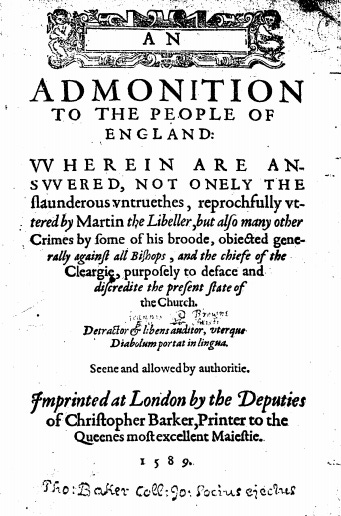Glossary
Pamphlet

Other languages
- Dutch: pamflet, vlugschrift, blauwboekje (specific forms: schuitenpraatje, liedje, traktaat, libel, paskwil, smaadschrift)
- French: pamphlet (specific forms: libelle, pasquinade, canard, mazarinade)
- German: Flugschrift
- Italian: foglio volante, foglio sciolto (specific forms: libello famoso, pasquinata)
- Polish: druk ulotny (specific forms: pamflet, paszkwil, druk polemiczny)
- Spanish: panfleto, libelo, pasquín
Material form
Printed bookSubject
Music and performative literature, News and current affairs, Religion and moralityDescription
Among the most printed genres of all popular literature during the early modern period was the pamphlet. Usually the pamphlet is defined according to its physical characteristics and its corresponding uses. Pamphlets were commonly printed in quarto or octavo format with one to twelve sheets. This means that pamphlets were fairly small booklets ranging from 4 to 96 pages. The pages were often unbound and uncut. As a result, they were among the cheapest of popular prints. Often they did not contain any illustrations, but sometimes an image featured on the title page. Almost exclusively written in the vernacular, they were typically short writings of a polemic or propagandistic nature on topical (social, political, religious) issues. The culture of pamphleteering developed mostly during the 16th century in the wake of religious and political conflicts among Protestants and Catholics in many parts of Europe. Polemical pamphlets flourished in Germany already in the second quarter of the sixteenth century, in the early years of the Reformation.
The term is probably derived from the 14th-century rendering of a 12th-century love poem in Latin, Pamphilus seu de Amore, with the name Pamphilus meaning ‘beloved of all’. With the rise of print, the term pamphlet (as the vernacular diminutive of Pamphilus) came to stand for a short, separate publication. By the 18th century, the pamphlet became a more widely used term for any small book, synonymous with libellus (from which libel is derived).
Though pamphlets could take many forms, by far the most common forms were open letters, printed dialogues, political (protest) songs, non-periodical news publications, woodcut prints with a short accompanying text, and government publications.
From its earliest uses as popular print, pamphlets were connected to libel and slander as an extension of the political arena and as a form of public opinion creation. Hence the term pamphlet, even by pamphleteers, was almost exclusively used in a negative context. Much of the development of pamphleteering can also be traced to the fierce polemics between Catholics and Protestants, orangists and statists (in the Dutch Republic), or royalists and republicans. In general, then, pamphlets were literature at the intersection of news and political criticism/satire.
In England, the term ‘pamphlet’ became widespread by the 1580s, and the culture of pamphleteering can be said to have taken off only around the 1630s and 1640s as the genre became truly distinctive from other forms of popular print such as the aviso.
For the Dutch Republic, the term pamflet was rarely used before 1700 and only gained currency around 1800. Contemporaries would have spoken of vlugschriften, blauwboekjes, liedjes (i.e. songs), traktaten, libels or paskwils.
In similar vein, in France, pamphlet became a current term only around the 18th century. Before that, it tended to be used to refer to English pamphlets.
In Italy, politically-themed fogli volanti tended to be in the form of a song, printed as broadsheets, and therefore perhaps could be considered ballads.
Related terms
news pamphlet, libel/pasquil, martyr story, criminal narrative, book of secrets, sermon, relation
Sources
S.K. Barker, ‘International News Pamphlets’, in: E. Smith and A. Kesson (eds.), The Elizabethan Top Ten: Defining Print Popularity in Early Modern England (London/New York: Routledge, 2013), 145-155.
D. Bellingradt, Flugpublizistik und Öffentlichkeit um 1700. Dynamiken, Akteure und Strukturen im urbanen Raum des Alten Reiches (Stuttgart: Franz Steiner Verlag, 2011).
A. Castillo Gómez, ‘Leer en la calle: coplas, avisos y panfletos aúreos’, Literatura: teoría, historia y crítica, 7 (2005), 15-43. See: http://www.revistas.unal.edu.co/index.php/lthc/article/viewFile/60108/57285
R. Darnton, ‘An Early Information Society: News and the Media in Eighteenth-Century Paris’, American Historical Review 105 (2000), 1-35.
F. Deen, D. Onnekink, M. Reinders (eds.), Pamphlets and Politics in the Dutch Republic (Leiden/Boston: Brill, 2011).
C. Dingemanse, Rap van tong, scherp van pen; literaire discussiecultuur in de Nederlandse praatjespamfletten (circa 1600-1750) (Hilversum: Verloren, 2008).
H. Ettinghausen, How the Press Began: Pre-Periodical Printed News in Early Modern Europe (A Coruña: SIELAE, 2015).
C. Harline, Pamphlets, Printing, and Political Culture in the Early Dutch Republic (Dordrecht etc.: Nijhoff, 1987).
R. Harms, Pamfletten en publieke opinie: massamedia in de zeventiende eeuw (Amsterdam: Amsterdam University Press, 2011).
J. Hyde, J. Raymond, M. Rospocher, Y. Ryan, A. Schaffer, H. Salmi, Communicating the News in Early Modern Europe. Cambridge Elements series (Cambridge: Cambridge University Press, forthcoming 2023).
R. Jagersma, Pamflethandel. Productie, distributie en consumptie van pamfletten in de Nederlandse Republiek rond 1700, dissertation University of Amsterdam, 2022.
W.P.C. Knuttel, Catalogus van de pamfletten-verzameling berustende in de Koninklijke Bibliotheek (The Hague: [Koninklijke Bibliotheek], 1889-1920; reprinted with additions Utrecht: HES Publishers, 1978).
J. de Kruif, M. Meijer Drees, J. Salman (eds.), Het lange leven van het pamflet: boekhistorische, iconografische, literaire en politieke aspecten van pamfletten 1600-1900 (Hilversum: Verloren, 2006).
J. Peacey, Politicians and Pamphleteers: Propaganda during the English Civil Wars and Interregnum (Aldershot: Ashgate 2004).
J. Raymond, Pamphlets and Pamphleteering in Early Modern Britain (Cambridge: Cambridge University Press, 2003).
U. Rozzo, La strage ignorata. I fogli volanti a stampa nell’Italia dei secoli XV e XVI (Udine: Forum, 2008), 43-95.
R. Salzberg, Ephemeral City: Cheap Print and Urban Culture in Renaissance Venice (Manchester: Manchester University Press, 2014).
J.K. Sawyer, Printed Poison. Pamphlet Propaganda, Faction Politics, and the Public Sphere in Early Seventeenth-Century France (Berkeley: University of California Press, 1990).
J. Schwitalla, Flugschrift (Berlin: De Gruyter, 1999).
P.J. Voss, Elizabethan News Pamphlets: Marlowe, Shakespeare, Spenser and the birth of Journalism (Pittsburg, PA: Duquesne University Press 2001).
R. Wilhelm, Italienische Flugschriften des Cinquecento (1500-1550): Gattungsgeschichte und Sprachgeschichte (Tübingen: Niemeyer Verlag, 2011).

